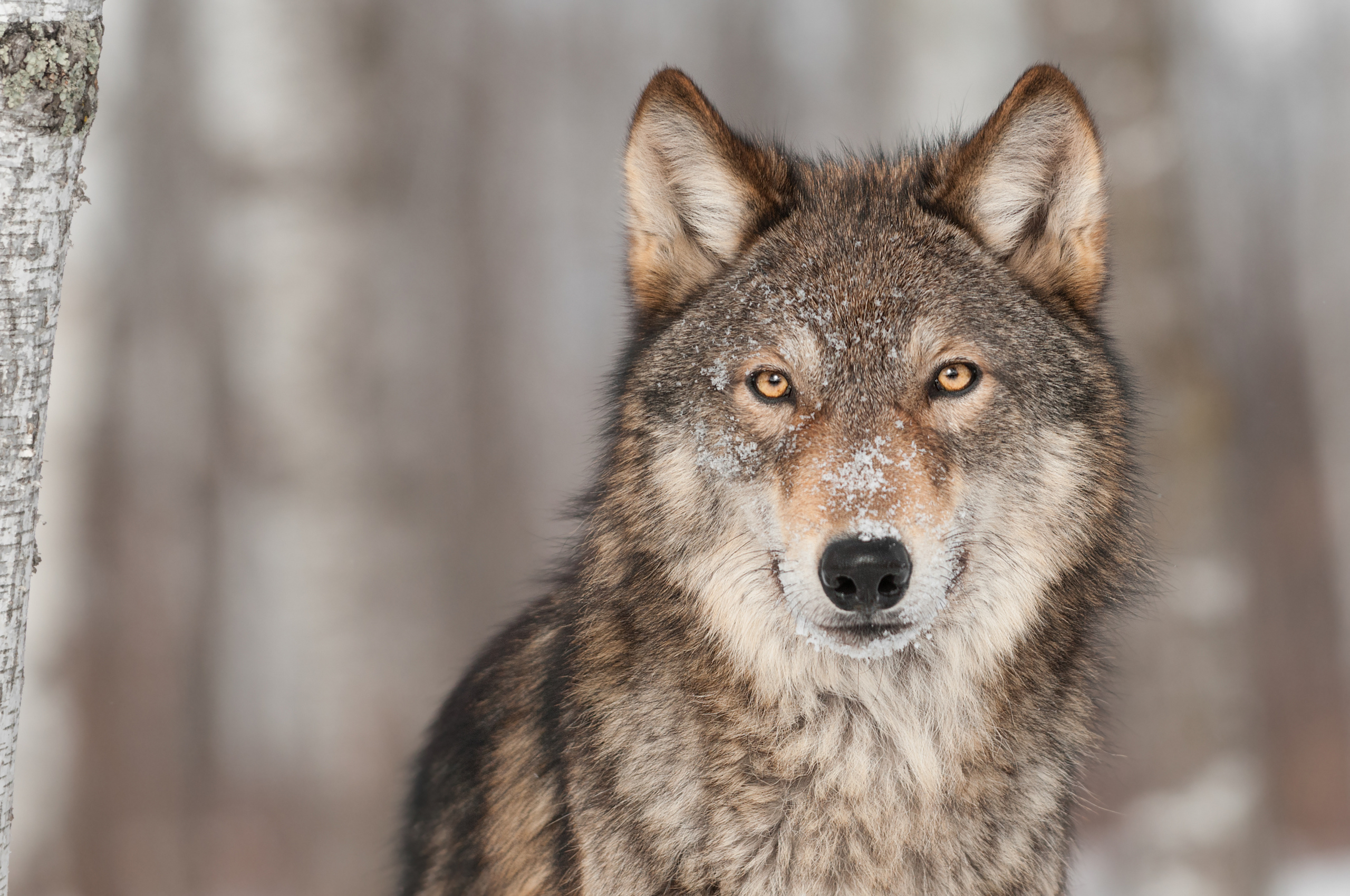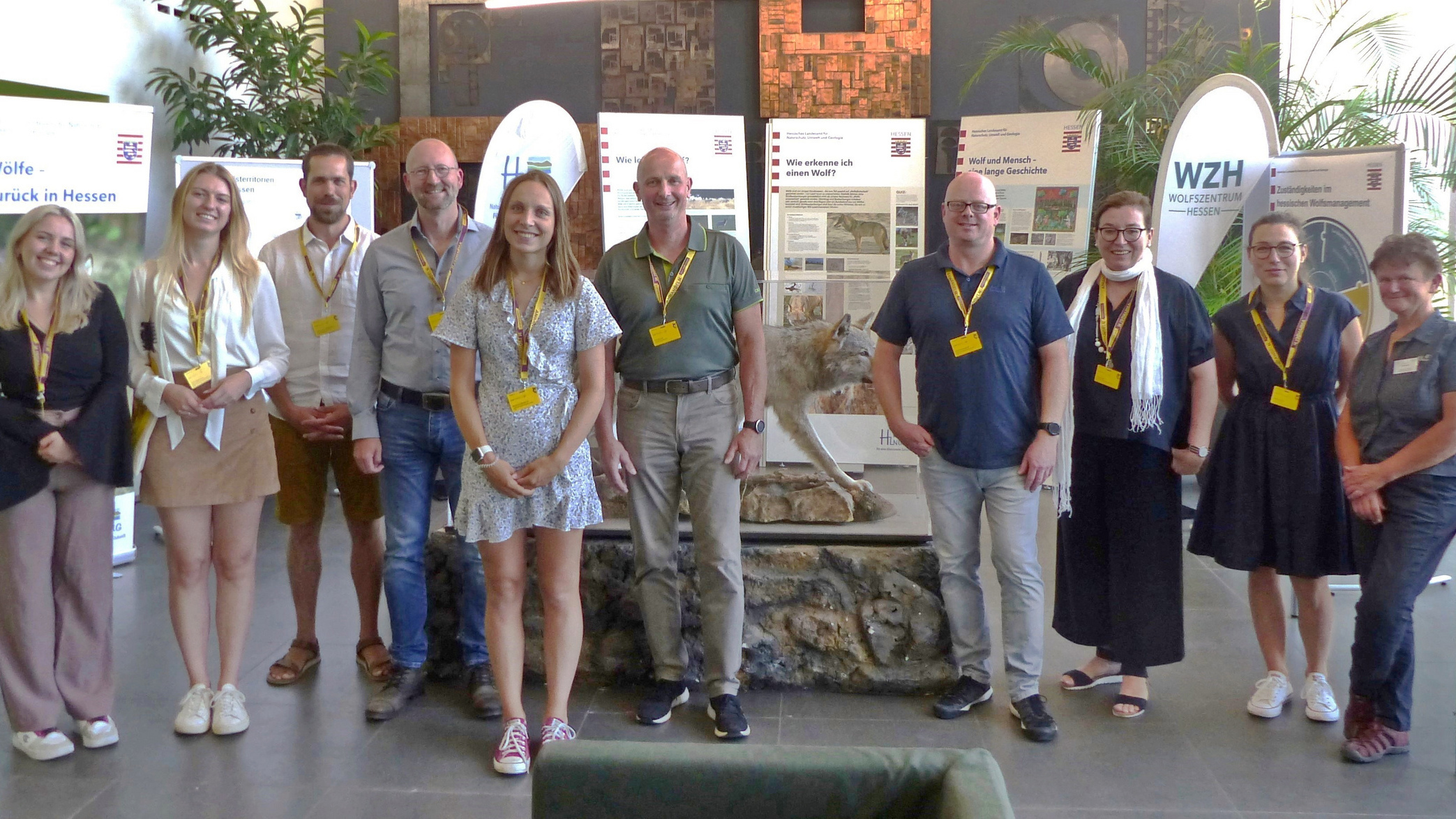The Wolf Controversy

At the end of the three-semester lecture and seminar series “The Animal-Human Relationship” in the Interdisciplinary Study Programme Social and Cultural Sciences, students and experts discuss how to deal with the predator that is increasingly roaming Germany’s countryside once again. Recognising the benefits of a culture of debate based on facts and objectivity is particularly important in this context.
By Alexandra Welsch, 25.7.2023
It has piercing eyes, a long, pointed muzzle and a resolute gait. Even when stuffed and on display in a glass cabinet, like here in “Café Glaskasten” at Darmstadt University of Applied Sciences, the wolf is an animal that leaves a lasting impression. All the more so since it is increasingly roaming Germany’s countryside once again – coming home, as it were, after its near extinction. As a life-size exhibit and above all as a topic of controversial discussion, it recently also found its way to h_da on “Wolf Day” at the end of the series of courses on “The Animal-Human Relationship” within the Interdisciplinary Study Programme Social and Cultural Sciences. Here, it became clear that the return of the wolf is a challenge for modern humans and their culture of debate.
“The animal-human relationship needs recalibrating in many places,” says Matthias Herrgen, an anthropologist from the Faculty of Social Sciences, explaining the concept of the lecture and seminar series. “In very many areas, we are noticing that the animal is acquiring a different status.” At an earlier symposium, for example, many students were surprised to hear from a representative of Merck, a pharmaceuticals company, that they were working hard on animal-free alternatives for drug testing. Herrgen also mentions the general debate on animal ethics or vegetarianism. “The topic is very popular among students,” he says. There is great awareness towards environmental protection and animal welfare, and many get actively involved.
“The wolf is the animal that polarises the most”
The wolf is a suitable example because it is here that the nature-culture conflict is particularly visible. “The wolf is the animal that polarises the most.” Herrgen emphasises that they – as scientists – consciously address this topic because the debate is partly very emotional. Nicola Erny, Professor of Philosophy at the Faculty of Social Sciences, also highlights the wolf’s special role in this context. At the beginning of “Wolf Day”, she sent a kind of reminder to the audience: “The university is manifesting itself here as the place where controversial topics are negotiated objectively.”
Professor Nicola Erny has taught philosophy at the Faculty of Social Sciences of Darmstadt University of Applied Sciences since 2010. Her main research interests are applied ethics and social philosophy.
Dr Matthias Herrgen is an anthropologist and lecturer for special duties at the Faculty of Social Sciences. Together with Nicola Erny, he is responsible for the series “The Animal-Human Relationship”.
Students tap frantically on their laptops and take line after line of notes during the fact-filled lecture on “The Wolf Problem” by biologist Dr Dirk Wewers, zoo inspector and curator at Nordhorn Zoo in Lower Saxony. He made it clear right from the outset that he himself is caught between two stools: his zoo keeps wolves, and he, in turn, keeps sheep near which a pack of wolves has settled. But he also made it clear that he welcomes the wolf’s return. After all, the following naturally applies: “The grey wolf is native to Germany.”
Until well into the last century, the largest predator from the dog family was hunted in Germany on a large scale. At that time, there were relatively few forest fauna and farm animals were not as well protected as they are today, as Wewers explained. “The wolf started to compete with humans for food.” The last wolf was shot in Hesse in 1841, he reported, and the last one in Germany in 1904. And it was only when it was placed under protection decades later in the 1990s that it gradually returned. In 2022, 161 packs, 43 pairs and 21 individuals were counted around the country. Monitoring with imaging cameras, on-site genetic sampling and transmitters help to keep an eye on them. This is how we know, for example, that some young animals roam 70 kilometres in a single night.
Nine attacks on humans since 1950
Wewers also voiced the opinion that scaremongering is unfounded. Point 1: “The development is diminishing.” Since a wolf pack lays claim to a territory 100 to 350 km2 in size, the population will eventually reach a limit purely because of space. Point 2: “Humans are not their typical prey.” According to the NINA Report by the Norwegian Institute for Nature Research, there have been nine attacks on humans in Germany since 1950, five of which were rabid attacks and four provoked by humans feeding them. Wewers: “I’d be far more scared of encountering a wild boar.” And he wasn’t too worried about deer either: a wolf pack of about ten animals eats 200 deer a year, he said. Over 200,000 deer succumbed to roadkill in 2019 alone, he added, and another 1.26 million were shot.

Then, from time to time, things indeed got a bit bloody: the speaker beamed photos onto the wall of the glass cabinet of sheep bitten to death and goats ripped to shreds. And then spoke of the damage to livestock that the wolf undoubtedly causes – whereby, however, the wolf can be ruled out in 50 percent of cases. “The perpetrator was often a dog.” Nevertheless, he is familiar, not least from his own experience, with the personal dismay felt by animal owners. They receive support in the form of compensation if their animals are killed by wolves despite safeguards such as electric fences. And if an animal repeatedly causes problems, the authorities can grant permission to shoot it. Ulrich-Götz Heimberger of the Nature Conservation Department of Darmstadt Regional Council, who was in the audience, confirmed this: “We currently have a wolf that has come close to sheep several times although they are sufficiently protected.” For the first time in Hesse, the question of whether a wolf should be shot is under discussion, he said. This would also have the effect of warning the rest of the pack.
Livestock owners demand: “Regulate the wolf population”
But for Volker Lein, Vice President of the Hessian Farmers’ Association, this did not go far enough. “Regulate the wolf population, otherwise livestock farming doesn’t stand a chance”: this demand was the title of his presentation. “As a livestock farmer, you suffer financially and have a completely different standpoint,” said Lein, the owner of a dairy farm in Homberg, who is also an evaluator for damage caused by wildlife. He presented some figures, according to which 56 sheep, ten deer and two calves were bitten to death in Hesse in the first half of 2023. “Livestock are the easiest source of food because they are penned in.” Of course, he said, better fencing would help, but added that it is impossible to meet all the specifications. Erecting fencing on difficult ground or terrain, for example, is impossible. Apart from which, the wolves are quite capable of jumping over it.
Whether compensation or fencing: “It’s not enough for us,” said Lein, summing up. Instead of spending millions and millions of euros on herd protection, the authorities should give permission to shoot not just wolves that are causing problems. Especially because since 2007 the wolf is no longer considered an endangered species. And after all, it is hunted in 14 of the EU member states. He too agreed that “the wolf is part of nature,” adding “and we don’t want to shoot wolves indiscriminately either – but there has to be a limit. And for us that includes taking them down.”
“We’re actually not that far apart”
Let wolves be wolves or should their population be limited? The participants oscillated between these poles in two discussion groups and the panel debate. “It’s a question of who is affected and how,” said Volker Lein from the Farmers’ Association, putting it in a nutshell. “We’re actually not that far apart,” said biologist Dirk Wewers. And finally, Professor Nicola Erny pointed out once again the responsibility to reflect objectively on one’s own, usually anthropocentric standpoint in order to be able to further address this sociopolitically explosive topic appropriately in the ongoing debate.
Her students have long been aware of the need for scientific differentiation and applied it accordingly: “We agreed that the wolf should be protected, but its population regulated,” said student Mathilda Waidelich, summarising a key result from her discussion group. “Banishing it is not a solution,” added Nora Hameister on behalf of the other group. “We have to find a balance and learn to live between these two poles.”
Contact
Christina Janssen
Science Editor
University Communication
Tel.: +49.6151.533-60112
Email: christina.janssen@h-da.da
Translation: Sharon Oranski
Further information about the Hessian Wolf Centre (in German):
www.hlnug.de/themen/naturschutz/tiere-und-pflanzen/arten-melden/wolfszentrum
You can read an interview with Nicola Erny and Matthias Herrgen on the launch of the series "Animal-Human Relationship" at the Department of Social Sciences at the h_da here: impact.h-da.de/en/animal-ethics

